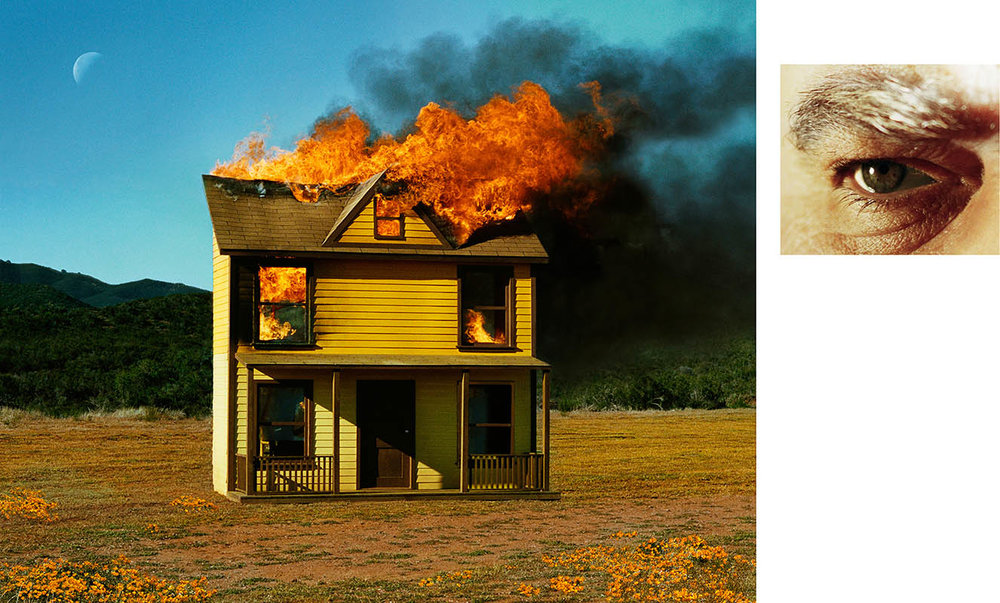Below is an interview with Alex Prager which I did in 2012 for copypasteculture, platform for visual culture.
Alex Prager
Born in 1979, Alex Prager is a self-taught American photographer and filmmaker who lives and works in Los Angeles. Copypasteculture met up with her to talk about her show in Foam photography museum in Amsterdam.

Martijn Savenije: Hi Alex, thank you for taking the time for an interview. How are you enjoying Amsterdam?
Alex Prager: It’s great, it’s a beautiful place. We [Prager, her studio manager and her sister Vanessa. – Ed.] went boating on the canals and we went cycling through the city. I even enjoyed it when it started to rain, we never get that in California.
Martijn Savenije: You’re here for your show Compulsion in FOAM photography museum. Most of the images in the show are diptychs. They show disaster scenes from a distance and close-ups of eyes depicting emotions. Why’d you choose this combination?
Alex Prager: I had been working on the disaster scenes for about eight months and there was finally a moment when I decided to look at them all together. Just to really evaluate what I had done because when I was working on them I was really ‘in it’. I wasn’t thinking about how they were coming out, I was just thinking about making them and I was just really involved.
So it was really nice to step away for the first time and look at what the show was starting to form into. When I did that, I was really happy with the distant disconnected feeling that the scenes gave you. That’s because they were very much inspired by the way the media sensationalizes accidents and disaster and things like that. So I needed to have that distance, but I felt that it was missing something really important to be able to connect to the emotional aspect of what was occurring.
But I didn’t want it in the picture, so that’s when I started experimenting with different close-ups of body parts. I tried different hand movements, mouths, feet and also tried close ups of eyes. When I looked at the proof sheets afterwards, the eyes were the most intense. So pairing them up together gave the emotional, human part of what was missing in the pictures.

MS: Where does the title Compulsion come from?
AP: Well, I was looking at a lot of Weegee and Enrique Metinides – also a crime scene photographer – and one thing that made them stand out from other crime scene photographers, besides their obvious talent for making crime scene photographs beautiful, was that they would include some of the spectators. And also the spectator’s reactions.
Just the spectator example of wanting to look at a crime scene or wanting to read about it from a very safe distance, was very important to this work.
That’s a big part of our world now; people willing to sign online petitions very easily but there’s very little action being taken sometimes. So it’s the compulsion to look from a safe distance.
MS: Isn’t that what a photographer usually does?
AP: Yeah *laughs*, but hopefully they do something with their observations.
MS: Like telling a story, for instance? What is the story we should get from Compulsion?
AP: Well, there’s a lot of different stories. I think it’s best to leave it up to the viewer, because I can only talk about why I decided to do Compulsion, and of course there’s a lot of deeper meanings that go with the series. That is evident in the work, but the way I got into it, is when I first got into taking pictures I was always very attracted to wanting to show these darker subject matters and these uncomfortable things which exist in the world. I would exhibit these pictures that I was taking and no one would want to look at them. It was impossible for me to engage anyone to want to look at the photographs, so that’s when I started working on the last three shows I had. Polyester, the Big Valley and Weekend. Because that was almost like a study of beauty and how beauty and color can mask darker and more uncomfortable subject matters.
I look at those series as a trilogy. So when I finished that trilogy I felt I knew enough about using beauty as a mask and that I could go talk about any subject matter that I wanted and still be able to engage the viewer.

MS: Is that where the nostalgic feeling of your photographs comes from?
AP: During the decades before the 90s, starting from the 40s, people were using a lot more color in design, fashion & make-up. Everything was a lot more theatrical-looking, so when I touch upon those older eras, all of that is like a playground for me. But in my natural affinity for all of that, I found that those bright colors, the textures and the staged scenes with the boxy cars add to that mask. Things looking so theatrical, cinematic and beautiful help saying anything within that pictures.
MS: You had your first show about six months after you started photography, right? Did you have trouble getting people to go and see those first shows?
AP: Oh, I was so not ready for a show. I was just taking pictures of whatever any student photographer would generally take pictures of. So people would go, but no one would want to buy anything.
When I was two years in, I realised that these darker subject matters were what interested me the most. So I’d have shows with that work and people would look at it and maybe I’d sell one print to a close friend of mine who just wanted to support me. Nobody was really connecting with this work, so I knew I’d really need to change something because the sole purpose of being an artist is to be able to communicate. I obviously wasn’t communicating because no one was wanting to listen to what I was saying. I was struggling for a long time and was about seven years in when I learnt that lesson.
MS: Sounds like a valuable lesson. What is the biggest mistake an aspiring photographer can make?
AP: To not trust their instinct. I think trusting my instincts has led me to do the work I’m doing now. We’re all unique, we’re all born different, no one is going to think exactly like you. People have different experiences and have a unique track in their lifetime. There’s no one that has lived exactly the same life, so we’re automatically born with a gift of uniqueness. So if you just trust that and not try to copy other artists & photographers. If you build on your instinct, it’s a scientific fact that your work will be unique, genuine and pure. But that’s probably the hardest thing to do, just to be youself. It takes a lot of work to be able to trust yourself and listen to your instinct.
MS: How do you make sure you achieve that? How do you go about your work to make it unique?
AP: Well, I never have a plan when I’m starting off. I’ll just start shooting and that’s the most scary part of the process because after each show it’s basically starting over from nothing. Everything I’ve learnt, everything I’ve worked on is gone and I need to start over with a blank canvas. After Compulsion, that’s exactly where I’m at now, awesomely *laughs*
So, it’s always very scary walking into the unknown and the only weapon you have are your instincts. So I just start shooting and I take a lot of really bad pictures for several months usually, until something starts to stand out. And even if it’s not necessarily a good picture, I can feel that there’s something in that directions which feels right. Then I just start following that. Sometimes that’ll lead me to a dead end, and sometimes it doesn’t. Like trial and a lot of error. I’m always working on stuff.
MS: Don’t you ever get dry spells?
AP: Sure I do. Then I go to the beach, go on hikes in Griffith Park, cook and you know, just live life and always keep looking for things in the back of my mind. I’ll look through my old notes, scour museums and artbooks. You know, all the normal things. And sometimes traveling can shake things up for me.
MS: So is there anything you’re taking away from being here in Amsterdam?
AP: *laughs* Besides me wanting to move here, you mean?
Alex Prager‘s show Compulsion can be seen in FOAM Photography Museum until October 14th, 2012.

